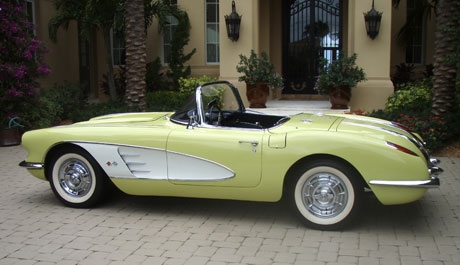For 1958, only 190 Corvettes had the Panama Yellow paint with white contrasting coves combination, making this a very rare car. Even more rare, this car was ordered without a radio or heater. Its period-correct 283/245 engine is now equipped with a single carburetor, but a dual-carburetor setup goes with the sale. The engine is matched to a four-speed manual transmission. The frame-off restoration includes a completely rebuilt motor and transmission, and an attractive period-correct black interior.
SCM Analysis
Detailing
| Vehicle: | 1958 Corvette 283/245 Convertible |
| Years Produced: | 1958 |
| Number Produced: | 9,168 |
| Original List Price: | $3,591 |
| SCM Valuation: | $90,000–$100,000 |
| Tune Up Cost: | $500 |
| Distributor Caps: | $25 |
| Chassis Number Location: | Top of steering column under hood |
| Engine Number Location: | Right-front cylinder-head deck |
| Club Info: | National Corvette Restorers Society 6291 Day Road Cincinnati, OH 45252 |
| Website: | www.ncrs.org |
| Alternatives: | 1957 Ford Thunderbird E-code 1959-61 Jaguar XK 150 3.4 roadster 1956-1958 Porsche 356 A Speedster |
| Investment Grade: | A |
This car sold for $93,500 at the Barrett-Jackson auction at the South Florida Fairgrounds in Palm Beach, FL on April 9, 2011.
The year 1958 was the breakout year for quad headlights, and the Corvette—along with most everything else from Detroit that year—adopted them. It was a dangerous omen that seemed to predict the oversizing and gingerbreading of the Corvette would soon follow, much as what happened to the second-generation Ford “Squarebird,” but fortunately, that ultimately never happened. And so, despite the styling change, the ’58 model eventually became the most commercially successful to date for the young Corvette nameplate, selling 9,168 units compared to just 6,339 units in 1957—an impressive 45 percent bump in a single model year.
Next to fuel injection or maybe a supercharger, dual quads were as burly a setup as you could get for the street in the late 1950s. Yet some mention of this ’58 Corvette’s dual carburetors is in order here. For 1958, there were five 283-ci Corvette engines available. The base V8 produced 230 horsepower with a single Carter carb. Next up was our subject Corvette, which had a dual-Carter, 245-horsepower version. But there were still three more rungs on the performance ladder to go, including a 250-horsepower Rochester Fuelie, a 270-horsepower, higher-performance, dual-quad Carter setup, and finally, the revered 290-horsepower Rochester Fuelie.
Low-output dual quads not that impressive
So if you want to get all critical about it, the fact that the original owner eschewed a radio and heater (a substantial $241.30 worth of options at the time) meant he theoretically had money left to invest in the higher-output, dual-quad system (priced at $182.95), which cost only a nominal $32.30 more than the $150.65 he spent on this lower-output dual-quad system. So what was the problem, Jake? It probably means that ultimately, the original owner was seeking not ultimate performance, but rather the status of a dual-quad Corvette—without spending a ton of dough. Hence the pass on a radio and heater.
But fast-forward 53 years, and the fact that the car was equipped with a single carb for the sale suggests that the dual-carb setup was recalcitrant—which is not exactly strong bid bait for a would-be buyer. Perhaps the price would have been higher if the seller had taken the trouble to make the dual-quad setup function properly. However at least the car was authentically prepared under the hood, right down to the natural-looking finishes, period-correct hose clamps and appropriately plated parts.
Panama Yellow unpopular – for a good reason
Although beautifully restored with appropriate finishes and detailing throughout, the somewhat effete Panama Yellow was probably not everyone’s favorite. No wonder the color is rare today–hardly anyone ordered it! Which is an insight into how collectible cars are sometimes presented today. If something was unpopular then, you can just say it’s rare now. Very convenient. My usual retort is that whooping cough is also rare, but it doesn’t mean you want it…
The unfortunate Panama Yellow color also brings up another point: Whether to restore a Corvette to its factory-original spec or choose a new color. There is no right or wrong here, since once a repaint is determined to be necessary, the car will never be original again anyway. So I say, if you’re doing up a personal driver, choose a factory color from the period you like. Our rights include life, liberty and the pursuit of happiness, remember? But if you’re doing a restoration for resale, staying with the original OE color is the safest path. A few people may lament that OE color, but a lot more will take shots at the car if it deviates from original spec. So in this case, the restorer did the right thing.
Inside, the black interior was nicely completed, although the seat cushions look a wee bit overstuffed. Which means they’re begging for some thousand-mile road trips to nestle them in properly and become “just right.” Also, compared to the typical garish red interiors, the black is understated, classic, and timeless. Nothing to dislike here at all.
Considering that many solid-axles sell for well into six figures—and considering its high level of restoration—this one looked like a relative bargain, as long as you can deal with the Panama Yellow and the lower-output, dual-quad setup. But if that’s happily the case, then all you’ll need is a nice Panama hat to match—preferably yellow. Let’s call Lot 689.4 fairly bought and sold
